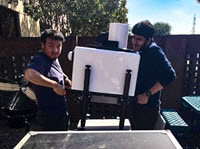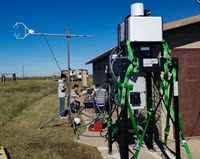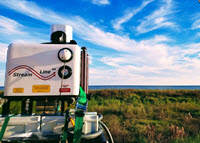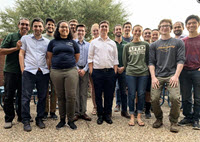
Hydrocarbons from oil slicks floating on the ocean’s surface can be aerosolized by evaporation, breaking waves and bursting bubbles. Variations in sea, wave, and atmospheric conditions can significantly influence the transport and dynamics of these aerosolized oil droplets. Accurate predictions of where and how far aerosolized oil pollutants will go can help us better understand potential human health impacts from oil spills, which was a concern during Deepwater Horizon.
Yajat Pandya collects and analyzes in situ wind, wave, and atmospheric data to help improve our understanding of how the marine atmospheric boundary layer, where the atmosphere meets and interacts with the ocean, affects how aerosolized oil droplets travel. His findings will help improve numerical Large-Eddy Simulation (LES) predictions of aerosolized oil droplets’ evolution from sea to coast, especially how different atmospheric and sea-wave conditions drive aerosols’ distribution and concentration as they travel.
Yajat is a Ph.D. student with the University of Texas at Dallas’s School of Engineering & Computer Science and a GoMRI Scholar with the project Transport of Aerosolized Oil Droplets in Marine Atmospheric Boundary Layer: Coupling Wind LiDAR Measurements and Large-Eddy Simulations.
His Path

Yajat’s interest in fluid flows and mathematics as a teenager led him to pursue a bachelor’s degree in aerospace engineering at the Indian Institute of Technology Kharagpur. As an undergraduate, he gained experience working with experimental fluid flows and focused his thesis project on small-scale wind turbines, which introduced him to complex atmospheric boundary layer flows. While exploring potential doctoral programs, he discovered that Dr. Giacomo Valerio Iungo was leading the Wind, Fluids, and Experiments (WindFluX) laboratory at the University of Texas at Dallas and had received a GoMRI-funded grant to investigate aerosolized oil transport. Yajat was excited to join Dr. Iungo’s lab team as a doctoral student.
“From a fluid dynamics perspective, anthropogenic large-scale atmospheric events are not understood well enough to develop confidence in predicting the harmful effects,” said Yajat. “The unfortunate Deepwater Horizon spill event provided me an opportunity to learn and share my understanding of oil droplets emerging from the coastal regions into the air and their transport via atmospheric motions.”
His Work

Yajat uses Doppler Wind LiDAR (Light Detection and Ranging) to measure wind speed and aerosol backscatter within 2 km of its deployment location to determine aerosol transport by turbulent atmospheric flows. He participated in a five-month deployment of his team’s Halo Photonics LiDAR and a sonic anemometer (an instrument that measures instantaneous wind speed) from the coast of Galveston, Texas. Collaborating with Galveston Island State Park, their team set up an experimental site 100 m from shore that allowed them to remotely access and monitor the equipment from their Dallas laboratory. They collected measurements of wind speeds, wave conditions, atmospheric stability, and weather conditions from November 2018 to April 2019. Multiple LiDAR scanning procedures provided an overview of local wind and aerosol trends, which helped the team design specific scans to capture turbulent flow in the marine atmospheric boundary layer. These scans included determining the vertical and horizontal spatial distribution of aerosol plumes, characterizing the variability of wind speed and aerosol concentration with high-frequency resolution, and characterizing features of the boundary layer profile.
Yajat observed that winds moving from sea to land exhibited significantly higher backscatter than winds moving from land to sea, suggesting that marine aerosols travel mainly toward the coastline. In winds from sea to land with speeds greater than 10 meters per second, aerosol plumes in the surf zone rose as high as 50 m above sea level, indicating the occurrence of unexpected aerosol buoyancy and turbulent diffusion (the mixing and dispersion of aerosol plumes emerging from the sea surface). Yajat applied fundamental flow theories to the data and found that the total aerodynamic roughness length (a parameter quantifying sea surface perturbation based on wind activity) that the instruments measured was significantly higher than existing open-sea aerodynamic roughness models predicted. The aerodynamic roughness regime significantly affects predictions of the turbulent scales of a boundary layer flow. In this case, the model’s underestimation of roughness may explain the inaccuracy in predicting how aerosols disperse in the coastal zone.

“This observation has led us to believe that there might be a dominant drag related to the roughness component, which is in turn dependent on implicit wind-wave processes,” explained Yajat. “Characterizing aerodynamic roughness length will help to provide more-efficient turbulent flow parameters for LES predictions of aerosol-particle transport.”
Next, Yajat will examine the correlation between atmospheric turbulence (small-scale, chaotic wind motions that vary in speed and direction) and aerosol backscatter. Based on a preliminary assessment of the data, he expects to find an inverse correlation between elevated wind turbulence and elevated aerosol concentrations. If confirmed by the research, he can use this correlation to create a model that can predict real-time aerosol structures in the marine boundary layer under varying wind speeds, wave heights, and atmospheric stratification.
His Learning

Dr. Iungo helped familiarize Yajat with the functionality and experimental procedures of the LiDAR and other analytical instruments and taught him data analysis techniques that focus on finding new insights. “One highlight of my research experience so far was realizing the deviation of my dataset from the known open-sea models and how much more we have to learn and solve,” said Yajat. While Dr. Iungo taught Yajat that scientific research often reveals valuable questions, whose answers can help strengthen one’s findings, he also emphasized the importance of not allowing new questions to distract from the main research goal.
“I feel special and blessed to be a part of a noble initiative aimed at minimizing the effects of devastating anthropogenic events like oil spills and marine pollution,” said Yajat. “The research has a unique purpose because everyone in the GoMRI community is motivated to save and preserve the ecosystem. As an experimentalist, it is particularly uplifting to see the incredible experimental efforts put forth by GoMRI researchers.”
Yajat hopes to find a research career where he can continue contributing to our understanding of aerosol turbulence under large-scale environmental events. He feels that successful scientific research results from training the curious part of your mind to be more focused and disciplined. “Many supplementary skills like problem solving and critical thinking are developed in the pursuit of your research goal,” he said. “Pushing the limits of human knowledge in your own unique way is fun and oddly satisfying!”
Praise for Yajat
Dr. Iungo reflected on Yajat’s research achievements, highlighting his significant contributions to the team’s LiDAR experiment in Galveston Island State Park. Yajat’s collaboration with his WindFluX lab mates resulted in a successful deployment of the mobile LiDAR station and the completely remote operation of their instruments. “I am very confident that his work will lead to new modeling strategies for predictions of marine aerosol concentration in the marine atmospheric boundary layer,” said Dr. Iungo.
The GoMRI community embraces bright and dedicated students like Yajat Pandya and their important contributions. The GoMRI Scholars Program recognizes graduate students whose work focuses on GoMRI-funded projects and builds community for the next generation of ocean science professionals.
By Stephanie Ellis and Nilde Maggie Dannreuther. Contact sellis@ngi.msstate.edu for questions or comments.
************
The Gulf of Mexico Research Initiative (GoMRI) is a 10-year independent research program established to study the effect, and the potential associated impact, of hydrocarbon releases on the environment and public health, as well as to develop improved spill mitigation, oil detection, characterization and remediation technologies. An independent and academic 20-member Research Board makes the funding and research direction decisions to ensure the intellectual quality, effectiveness and academic independence of the GoMRI research. All research data, findings and publications will be made publicly available. The program was established through a $500 million financial commitment from BP. For more information, visit http://gulfresearchinitiative.org/.
© Copyright 2010-2020 Gulf of Mexico Research Initiative (GoMRI) – All Rights Reserved. Redistribution is encouraged with acknowledgment to the Gulf of Mexico Research Initiative (GoMRI). Please credit images and/or videos as done in each article. Questions? Contact web-content editor Nilde “Maggie” Dannreuther, Northern Gulf Institute, Mississippi State University (maggied@ngi.msstate.edu).
